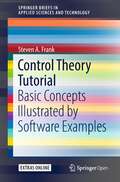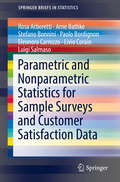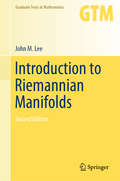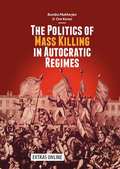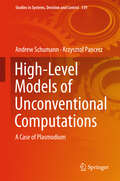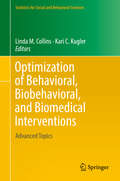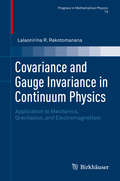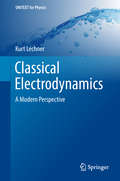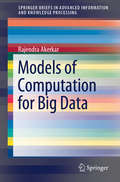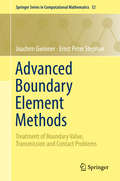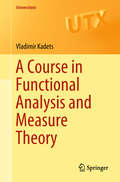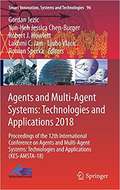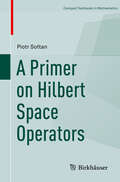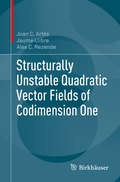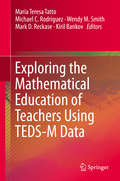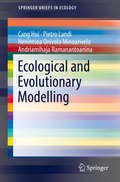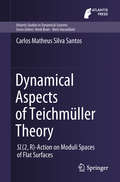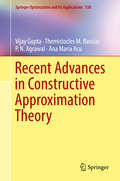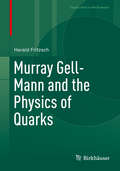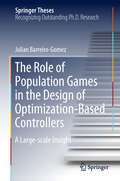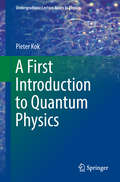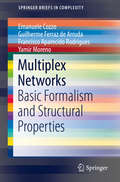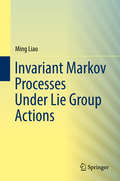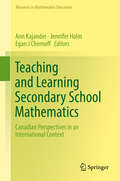- Table View
- List View
Pseudocompact Topological Spaces: A Survey of Classic and New Results with Open Problems (Developments in Mathematics #55)
by Michael Hrušák Ángel Tamariz-Mascarúa Mikhail TkachenkoThis book, intended for postgraduate students and researchers, presents many results of historical importance on pseudocompact spaces. In 1948, E. Hewitt introduced the concept of pseudocompactness which generalizes a property of compact subsets of the real line. A topological space is pseudocompact if the range of any real-valued, continuous function defined on the space is a bounded subset of the real line. Pseudocompact spaces constitute a natural and fundamental class of objects in General Topology and research into their properties has important repercussions in diverse branches of Mathematics, such as Functional Analysis, Dynamical Systems, Set Theory and Topological-Algebraic structures. The collection of authors of this volume include pioneers in their fields who have written a comprehensive explanation on this subject. In addition, the text examines new lines of research that have been at the forefront of mathematics. There is, as yet, no text that systematically compiles and develops the extensive theory of pseudocompact spaces, making this book an essential asset for anyone in the field of topology.
Control Theory Tutorial: Basic Concepts Illustrated by Software Examples (SpringerBriefs in Applied Sciences and Technology)
by Steven A. FrankThis open access Brief introduces the basic principles of control theory in a concise self-study guide. It complements the classic texts by emphasizing the simple conceptual unity of the subject. A novice can quickly see how and why the different parts fit together. The concepts build slowly and naturally one after another, until the reader soon has a view of the whole. Each concept is illustrated by detailed examples and graphics. The full software code for each example is available, providing the basis for experimenting with various assumptions, learning how to write programs for control analysis, and setting the stage for future research projects. The topics focus on robustness, design trade-offs, and optimality. Most of the book develops classical linear theory. The last part of the book considers robustness with respect to nonlinearity and explicitly nonlinear extensions, as well as advanced topics such as adaptive control and model predictive control. New students, as well as scientists from other backgrounds who want a concise and easy-to-grasp coverage of control theory, will benefit from the emphasis on concepts and broad understanding of the various approaches.
Parametric and Nonparametric Statistics for Sample Surveys and Customer Satisfaction Data (SpringerBriefs in Statistics)
by Stefano Bonnini Livio Corain Luigi Salmaso Rosa Arboretti Eleonora Carrozzo Arne Bathke Paolo BordignonThis book deals with problems related to the evaluation of customer satisfaction in very different contexts and ways. Often satisfaction about a product or service is investigated through suitable surveys which try to capture the satisfaction about several partial aspects which characterize the perceived quality of that product or service. This book presents a series of statistical techniques adopted to analyze data from real situations where customer satisfaction surveys were performed.The aim is to give a simple guide of the variety of analysis that can be performed when analyzing data from sample surveys: starting from latent variable models to heterogeneity in satisfaction and also introducing some testing methods for comparing different customers. The book also discusses the construction of composite indicators including different benchmarks of satisfaction. Finally, some rank-based procedures for analyzing survey data are also shown.
Introduction to Riemannian Manifolds: An Introduction To Curvature (Graduate Texts in Mathematics #176)
by John M. LeeThis text focuses on developing an intimate acquaintance with the geometric meaning of curvature and thereby introduces and demonstrates all the main technical tools needed for a more advanced course on Riemannian manifolds. It covers proving the four most fundamental theorems relating curvature and topology: the Gauss-Bonnet Theorem, the Cartan-Hadamard Theorem, Bonnet’s Theorem, and a special case of the Cartan-Ambrose-Hicks Theorem.
The Politics of Mass Killing in Autocratic Regimes
by Bumba Mukherjee Ore KorenThis book develops a detailed, disaggregated theoretical and empirical framework that explains variations in mass killing by authoritarian regimes globally, with a specific focus on Pakistan, Indonesia, and Malaysia. Using a combination of game-theoretic, statistical, and qualitative approaches, this project explicates when civilians within nondemocratic states will mobilize against the ruling elite, and when such mobilization will result in mass killing. In doing so, it illustrates the important role urbanization and food insecurity historically played, and will continue to play, in generating extreme forms of civilian victimization.
High-Level Models of Unconventional Computations: A Case Of Plasmodium (Studies in Systems, Decision and Control #159)
by Krzysztof Pancerz Andrew SchumannThis book shows that the plasmodium of Physarum polycephalum can be considered a natural labelled transition system, and based on this, it proposes high-level programming models for controlling the plasmodium behaviour. The presented programming is a form of pure behaviourism: the authors consider the possibility of simulating all basic stimulus–reaction relations. As plasmodium is a good experimental medium for behaviouristic models, the book applies the programming tools for modelling plasmodia as unconventional computers in different behavioural sciences based on studying the stimulus–reaction relations. The authors examine these relations within the framework of a bio-inspired game theory on plasmodia they have developed i.e. within an experimental game theory, where, on the one hand, all basic definitions are verified in experiments with Physarum polycephalum and Badhamia utricularis and, on the other hand, all basic algorithms are implemented in the object-oriented language for simulations of plasmodia. The results allow the authors to propose that the plasmodium can be a model for concurrent games and context-based games.
Optimization of Behavioral, Biobehavioral, and Biomedical Interventions: Advanced Topics (Statistics for Social and Behavioral Sciences)
by Linda M. Collins Kari C. KuglerBehavioral, biobehavioral, and biomedical interventions are programs with the objective of improving and maintaining human health and well-being, broadly defined, in individuals, families, schools, organizations, or communities. These interventions may be aimed at, for example, preventing or treating disease, promoting physical and mental health, preventing violence, or improving academic achievement. This book provides additional information on a principled empirical framework for developing interventions that are more effective, efficient, economical, and scalable. This framework is introduced in the monograph, "Optimization of Behavioral, Biobehavioral, and Biomedical Interventions: The Multiphase Optimization Strategy (MOST)" by Linda M. Collins (Springer, 2018). The present book is focused on advanced topics related to MOST. The chapters, all written by experts, are devoted to topics ranging from experimental design and data analysis to development of a conceptual model and implementation of a complex experiment in the field. Intervention scientists who are preparing to apply MOST will find this book an important reference and guide for their research. Fields to which this work pertains include public health (medicine, nursing, health economics, implementation sciences), behavioral sciences (psychology, criminal justice), statistics, and education.
Covariance and Gauge Invariance in Continuum Physics: Application to Mechanics, Gravitation, and Electromagnetism (Progress in Mathematical Physics #73)
by Lalaonirina R. RakotomananaThis book presents a Lagrangian approach model to formulate various fields of continuum physics, ranging from gradient continuum elasticity to relativistic gravito-electromagnetism. It extends the classical theories based on Riemann geometry to Riemann-Cartan geometry, and then describes non-homogeneous continuum and spacetime with torsion in Einstein-Cartan relativistic gravitation. It investigates two aspects of invariance of the Lagrangian: covariance of formulation following the method of Lovelock and Rund, and gauge invariance where the active diffeomorphism invariance is considered by using local Poincaré gauge theory according to the Utiyama method. Further, it develops various extensions of strain gradient continuum elasticity, relativistic gravitation and electromagnetism when the torsion field of the Riemann-Cartan continuum is not equal to zero. Lastly, it derives heterogeneous wave propagation equations within twisted and curved manifolds and proposes a relation between electromagnetic potential and torsion tensor.
Classical Electrodynamics: A Modern Perspective (UNITEXT for Physics)
by Kurt LechnerThis book addresses the theoretical foundations and the main physical consequences of electromagnetic interaction, generally considered to be one of the four fundamental interactions in nature, in a mathematically rigorous yet straightforward way. The major focus is on the unifying features shared by classical electrodynamics and all other fundamental relativistic classical field theories. The book presents a balanced blend of derivations of phenomenological predictions from first principles on the one hand, and concrete applications on the other. Further, it highlights the internal inconsistencies of classical electrodynamics, and addresses and resolves often-ignored critical issues, such as the dynamics of massless charged particles, the infinite energy of the electromagnetic field, and the limits of the Green’s function method. Presenting a rich, multilayered, and critical exposition on the electromagnetic paradigm underlying the whole Universe, the book offers a valuable resource for researchers and graduate students in theoretical physics alike.
Models of Computation for Big Data (Advanced Information and Knowledge Processing)
by Rajendra AkerkarThe big data tsunami changes the perspective of industrial and academic research in how they address both foundational questions and practical applications. This calls for a paradigm shift in algorithms and the underlying mathematical techniques. There is a need to understand foundational strengths and address the state of the art challenges in big data that could lead to practical impact. The main goal of this book is to introduce algorithmic techniques for dealing with big data sets. Traditional algorithms work successfully when the input data fits well within memory. In many recent application situations, however, the size of the input data is too large to fit within memory. Models of Computation for Big Data, covers mathematical models for developing such algorithms, which has its roots in the study of big data that occur often in various applications. Most techniques discussed come from research in the last decade. The book will be structured as a sequence of algorithmic ideas, theoretical underpinning, and practical use of that algorithmic idea. Intended for both graduate students and advanced undergraduate students, there are no formal prerequisites, but the reader should be familiar with the fundamentals of algorithm design and analysis, discrete mathematics, probability and have general mathematical maturity.
Advanced Boundary Element Methods: Treatment of Boundary Value, Transmission and Contact Problems (Springer Series in Computational Mathematics #52)
by Joachim Gwinner Ernst Peter StephanThis book is devoted to the mathematical analysis of the numerical solution of boundary integral equations treating boundary value, transmission and contact problems arising in elasticity, acoustic and electromagnetic scattering. It serves as the mathematical foundation of the boundary element methods (BEM) both for static and dynamic problems. The book presents a systematic approach to the variational methods for boundary integral equations including the treatment with variational inequalities for contact problems. It also features adaptive BEM, hp-version BEM, coupling of finite and boundary element methods – efficient computational tools that have become extremely popular in applications.Familiarizing readers with tools like Mellin transformation and pseudodifferential operators as well as convex and nonsmooth analysis for variational inequalities, it concisely presents efficient, state-of-the-art boundary element approximations and points to up-to-date research.The authors are well known for their fundamental work on boundary elements and related topics, and this book is a major contribution to the modern theory of the BEM (especially for error controlled adaptive methods and for unilateral contact and dynamic problems) and is a valuable resource for applied mathematicians, engineers, scientists and graduate students.
A Course in Functional Analysis and Measure Theory (Universitext)
by Vladimir Kadets Andrei IacobWritten by an expert on the topic and experienced lecturer, this textbook provides an elegant, self-contained introduction to functional analysis, including several advanced topics and applications to harmonic analysis. Starting from basic topics before proceeding to more advanced material, the book covers measure and integration theory, classical Banach and Hilbert space theory, spectral theory for bounded operators, fixed point theory, Schauder bases, the Riesz-Thorin interpolation theorem for operators, as well as topics in duality and convexity theory.Aimed at advanced undergraduate and graduate students, this book is suitable for both introductory and more advanced courses in functional analysis. Including over 1500 exercises of varying difficulty and various motivational and historical remarks, the book can be used for self-study and alongside lecture courses.
Agents and Multi-Agent Systems: Proceedings Of The 12th International Conference On Agents And Multi-Agent Systems: Technologies And Applications (KES-AMSTA-18) (Smart Innovation, Systems And Technologies #96)
by Lakhmi C. Jain Robert J. Howlett Gordan Jezic Yun-Heh Jessica Chen-Burger Ljubo Vlacic Roman ŠperkaProvides recent research on agents and multi-agent systems.<P><P> Includes proceedings of the 12th International KES Conference on Agents and Multi-Agent Systems: Technologies and Applications (KES-AMSTA 2018), held on Australia’s Gold Coast on June 20–22, 2018.<P> Presents technologies and applications of agents and multi-agent systems.<P> This book highlights new trends and challenges in agent systems, and new digital and knowledge economy research, and includes 34 papers on areas such as intelligent agent interaction and collaboration, modeling, simulation and mobile agents, agent communication and social networks, business Informatics, design and implementation of intelligent agents and multi-agent systems. These papers were presented at the 12th International KES Conference on Agents and Multi-Agent Systems: Technologies and Applications (KES-AMSTA 2018) held on Australia’s Gold Coast.<P> The modern economy is driven by technologies and knowledge. Digital technologies can free, shift and multiply choices, often intruding on the space of other industries, by providing new ways of conducting business operations and creating values for customers and companies. The book addresses topics that contribute to the modern digital economy, including software agents, multi-agent systems, agent modeling, mobile and cloud computing, big data analysis, business intelligence, artificial intelligence, social systems, computer embedded systems and nature inspired manufacturing, which contribute to the modern digital economy.<P> The results presented are of theoretical and practical value to researchers and industrial practitioners working in the fields of artificial intelligence, collective computational intelligence, innovative business models, new digital and knowledge economy and, in particular, agent and multi-agent systems, technologies, tools and applications.<P>
A Primer on Hilbert Space Operators (Compact Textbooks in Mathematics)
by Piotr SołtanThe book concisely presents the fundamental aspects of the theory of operators on Hilbert spaces. The topics covered include functional calculus and spectral theorems, compact operators, trace class and Hilbert-Schmidt operators, self-adjoint extensions of symmetric operators, and one-parameter groups of operators. The exposition of the material on unbounded operators is based on a novel tool, called the z-transform, which provides a way to encode full information about unbounded operators in bounded ones, hence making many technical aspects of the theory less involved.
Structurally Unstable Quadratic Vector Fields of Codimension One
by Jaume Llibre Joan C. Artés Alex C. RezendeOriginating from research in the qualitative theory of ordinary differential equations, this book follows the authors’ work on structurally stable planar quadratic polynomial differential systems. In the present work the authors aim at finding all possible phase portraits in the Poincaré disc, modulo limit cycles, of planar quadratic polynomial differential systems manifesting the simplest level of structural instability. They prove that there are at most 211 and at least 204 of them.
Exploring the Mathematical Education of Teachers Using TEDS-M Data
by Maria Teresa Tatto Michael C. Rodriguez Wendy M. Smith Mark D. Reckase Kiril BankovThis book uses the publicly available TEDS-M data to answer such questions as: How does teacher education contribute to the learning outcomes of future teachers? Are there programs that are more successful than others in helping teachers learn to teach mathematics? How does the local and national policy environment contribute to teacher education outcomes? It invites readers to explore these questions across a large number of international settings. The importance of preparing future mathematics teachers has become a priority across many nations. Across the globe nations have allocated resources and expertise to this endeavour. Yet in spite of the importance accorded to teacher education not much is known about different approaches to preparing knowledgeable teachers and whether these approaches do in fact achieve their purpose. The Mathematics Teacher Education and Development Study (TEDS-M) is the first, and to date the only, cross-national study using scientific and representative samples to provide empirical data on the knowledge that future mathematics teachers of primary and secondary school acquire in their teacher education programs. The study addresses the central importance of teacher knowledge in learning to teach mathematics by examining variation in the nature and influence of teacher education programs within and across countries. The study collected data on teacher education programs structure, curriculum and opportunities to learn, on teacher educators’ characteristics and beliefs, and on future mathematics teachers’ individual characteristics, beliefs, and mathematics and pedagogical knowledge across 17 countries providing a unique opportunity to explore enduring questions in the field.
Ecological and Evolutionary Modelling (SpringerBriefs in Ecology)
by Cang Hui Pietro Landi Henintsoa Onivola Minoarivelo Andriamihaja RamanantoaninaEcology studies biodiversity in its variety and complexity. It describes how species distribute and perform in response to environmental changes. Ecological processes and structures are highly complex and adaptive. In order to quantify emerging ecological patterns and investigate their hidden mechanisms, we need to rely on the simplicity of mathematical language. Ecological patterns are emerging structures observed in populations, communities and ecosystems. Elucidating drivers behind ecological patterns can greatly improve our knowledge of how ecosystems assemble, function and respond to change and perturbation. Mathematical ecology has, thus, become an important interdisciplinary research field that can provide answers to complex global issues, such as climate change and biological invasions.The aim of this book is to (i) introduce key concepts in ecology and evolution, (ii) explain classic and recent important mathematical models for investigating ecological and evolutionary dynamics, and (iii) provide real examples in ecology/biology/environmental sciences that have used these models to address relevant issues. Readers are exposed to the key concepts, frameworks, and terminology in the studies of ecology and evolution, which will enable them to ask the correct and relevant research questions, and frame the questions using appropriate mathematical models.
Dynamical Aspects of Teichmüller Theory: SL(2,R)-Action on Moduli Spaces of Flat Surfaces (Atlantis Studies in Dynamical Systems #7)
by Carlos Matheus Silva SantosThis book is a remarkable contribution to the literature on dynamical systems and geometry. It consists of a selection of work in current research on Teichmüller dynamics, a field that has continued to develop rapidly in the past decades. After a comprehensive introduction, the author investigates the dynamics of the Teichmüller flow, presenting several self-contained chapters, each addressing a different aspect on the subject. The author includes innovative expositions, all the while solving open problems, constructing examples, and supplementing with illustrations. This book is a rare find in the field with its guidance and support for readers through the complex content of moduli spaces and Teichmüller Theory. The author is an internationally recognized expert in dynamical systems with a talent to explain topics that is rarely found in the field. He has created a text that would benefit specialists in, not only dynamical systems and geometry, but also Lie theory and number theory.
Recent Advances in Constructive Approximation Theory (Springer Optimization and Its Applications #138)
by Vijay Gupta Themistocles M. Rassias P. N. Agrawal Ana Maria AcuThis book presents an in-depth study on advances in constructive approximation theory with recent problems on linear positive operators. State-of-the-art research in constructive approximation is treated with extensions to approximation results on linear positive operators in a post quantum and bivariate setting. Methods, techniques, and problems in approximation theory are demonstrated with applications to optimization, physics, and biology. Graduate students, research scientists and engineers working in mathematics, physics, and industry will broaden their understanding of operators essential to pure and applied mathematics. Topics discussed include: discrete operators, quantitative estimates, post-quantum calculus, integral operators, univariate Gruss-type inequalities for positive linear operators, bivariate operators of discrete and integral type, convergence of GBS operators.
Murray Gell-Mann and the Physics of Quarks (Classic Texts in the Sciences)
by Harald FritzschMurray Gell-Mann, Physics Nobel Prize Laureate in 1969 is known for his theoretical work on elementary particle physics and the introduction of quarks and together with H. Fritzsch the “Quantum Chromodynamics”. Based on four sections the Editor gives an overview on the work of Gell-Mann and his contributions to various aspects of the physics, related to quarks. His most important and influential papers were selected and reprinted so that the reader easily can check the original work of Gell-Mann.
The Role of Population Games in the Design of Optimization-Based Controllers: A Large-scale Insight (Springer Theses)
by Julian Barreiro-GomezThis book reports on the implementation of evolutionary-game theory in the design of distributed optimization-based controllers. First, it discusses how the classical population-game approach can contribute to and complement the design of optimization-based controllers. It shows how the features of this approach can be exploited to extend their capabilities in the solution of distributed optimization problems, and examines density games in order to consider multiple coupled constraints and preserve the non-centralized information requirements. Furthermore, it establishes a close relationship between the possible interactions among agents in a population with constrained information sharing among different local controllers. It also discusses coalitional games, focusing on the Shapley power index and proposes an alternative method of computing the latter, which reduces computational time, as well as a different way of finding it using distributed communication structures. All the proposed strategies are then tested on various control problems, such as those related to the Barcelona water supply network, multiple continuous stirred tank reactors, various unmanned aerial vehicle systems, and a water distribution system. This thesis, examined at the Universitat Politècnica de Catalunya and Universidad de los Andes in 2017, received the award for best thesis in control from the control group of the Spanish Committee of Automatic Control (CEA) in the same year.
A First Introduction to Quantum Physics (Undergraduate Lecture Notes in Physics)
by Pieter KokIn this undergraduate textbook, the author develops the quantum theory from first principles based on very simple experiments: a photon travelling through beam splitters to detectors, an electron moving through a Stern-Gerlach machine, and an atom emitting radiation. From the physical description of these experiments follows a natural mathematical description in terms of matrices and complex numbers. The first part of the book examines how experimental facts force us to let go of some deeply held preconceptions and develops this idea into a mathematical description of states, probabilities, observables, and time evolution using physical applications. The second part of the book explores more advanced topics, including the concept of entanglement, the process of decoherence, and extension of the quantum theory to the situation of a particle in a one-dimensional box. Here, the text makes contact with more traditional treatments of quantum mechanics. The remaining chapters delve deeply into the idea of uncertainty relations and explore what the quantum theory says about the nature of reality. The book is an ideal and accessible introduction to quantum physics, with modern examples and helpful end-of-chapter exercises.
Multiplex Networks: Basic Formalism and Structural Properties (SpringerBriefs in Complexity)
by Emanuele Cozzo Guilherme Ferraz de Arruda Francisco Aparecido Rodrigues Yamir MorenoThis book provides the basis of a formal language and explores its possibilities in the characterization of multiplex networks. Armed with the formalism developed, the authors define structural metrics for multiplex networks. A methodology to generalize monoplex structural metrics to multiplex networks is also presented so that the reader will be able to generalize other metrics of interest in a systematic way. Therefore, this book will serve as a guide for the theoretical development of new multiplex metrics. Furthermore, this Brief describes the spectral properties of these networks in relation to concepts from algebraic graph theory and the theory of matrix polynomials. The text is rounded off by analyzing the different structural transitions present in multiplex systems as well as by a brief overview of some representative dynamical processes. Multiplex Networks will appeal to students, researchers, and professionals within the fields of network science, graph theory, and data science.
Invariant Markov Processes Under Lie Group Actions
by Ming LiaoThe purpose of this monograph is to provide a theory of Markov processes that are invariant under the actions of Lie groups, focusing on ways to represent such processes in the spirit of the classical Lévy-Khinchin representation. It interweaves probability theory, topology, and global analysis on manifolds to present the most recent results in a developing area of stochastic analysis. The author’s discussion is structured with three different levels of generality:— A Markov process in a Lie group G that is invariant under the left (or right) translations— A Markov process xt in a manifold X that is invariant under the transitive action of a Lie group G on X— A Markov process xt invariant under the non-transitive action of a Lie group GA large portion of the text is devoted to the representation of inhomogeneous Lévy processes in Lie groups and homogeneous spaces by a time dependent triple through a martingale property. Preliminary definitions and results in both stochastics and Lie groups are provided in a series of appendices, making the book accessible to those who may be non-specialists in either of these areas.Invariant Markov Processes Under Lie Group Actions will be of interest to researchers in stochastic analysis and probability theory, and will also appeal to experts in Lie groups, differential geometry, and related topics interested in applications of their own subjects.
Teaching and Learning Secondary School Mathematics: Canadian Perspectives in an International Context (Advances in Mathematics Education)
by Jennifer Holm Ann Kajander Egan J ChernoffThis volume brings together recent research and commentary in secondary school mathematics from a breadth of contemporary Canadian and International researchers and educators. It is both representative of mathematics education generally, as well as unique to the particular geography and culture of Canada. The chapters address topics of broad applicability such as technology in learning mathematics, recent interest in social justice contexts in the learning of mathematics, as well as Indigenous education. The voices of classroom practitioners, the group ultimately responsible for implementing this new vision of mathematics teaching and learning, are not forgotten. Each section includes a chapter written by a classroom teacher, making this volume unique in its approach. We have much to learn from one another, and this volume takes the stance that the development of a united vision, supported by both research and professional dialog, provides the first step.

